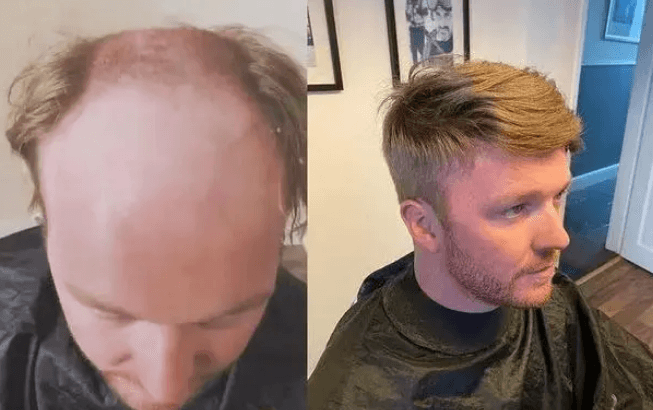1. Introduction
Hair loss is a common concern that affects millions worldwide, often leading to emotional distress and diminished self-esteem. While hair loss is not typically painful and doesn’t directly impact health, the psychological toll can be significant. Many individuals find themselves increasingly aware of their hair’s condition, constantly worrying about the potential for baldness. This article delves into the timeline from the onset of hair loss to the eventual transition to baldness, the factors that influence this process, and actionable strategies to slow hair loss.

2. Understanding Hair Loss
Hair loss, or alopecia, can manifest in various forms, each with distinct characteristics and underlying causes. The most prevalent type is androgenetic alopecia, commonly known as male or female pattern baldness. This hereditary condition results in gradual thinning of hair and is often marked by a receding hairline or thinning crown.
Other types of hair loss include:
- Telogen Effluvium: A temporary condition often triggered by stress, hormonal changes, or trauma, where hair follicles enter a resting phase.
- Alopecia Areata: An autoimmune disorder resulting in patchy hair loss, which can occur suddenly and may affect individuals of any age.
- Traction Alopecia: Caused by prolonged tension on hair from styles like tight braids or ponytails.
Understanding these conditions helps individuals recognize their specific type of hair loss and seek appropriate treatment.
3. Timeline from Hair Loss to Baldness
The journey from initial hair loss to complete baldness is highly variable. Medical literature suggests that this process can take anywhere from 5 to 25 years, but many experience noticeable changes within just a few years. Factors contributing to this wide range include genetics, the underlying cause of hair loss, environmental influences, and personal lifestyle choices.
For instance, some individuals may notice their first thinning strands in their twenties, while others might not face significant changes until their forties. A family history of early baldness can indicate a higher likelihood of rapid progression.
To illustrate, consider two hypothetical cases:
- Case A: A 25-year-old male notices thinning around the crown and hairline. Within two years, he experiences significant hair loss, ultimately leading to a shaved head by age 30. His pattern matches a family history of male pattern baldness.
- Case B: A 40-year-old female begins losing hair due to stress and hormonal changes. Her journey spans over ten years, with gradual thinning that she manages through dietary changes and topical treatments.
These cases underscore that individual experiences with hair loss can vary dramatically, highlighting the importance of personalized approaches to treatment and prevention.
4. Causes of Hair Loss
Several factors can contribute to hair loss, often interacting in complex ways. Key causes include:
- Genetics: The most significant factor, especially in androgenetic alopecia. Studies indicate that up to 80% of men and women with this condition have a family history of hair loss.
- Hormonal Changes: Fluctuations in hormones, particularly androgens, can lead to thinning hair. Conditions such as polycystic ovary syndrome (PCOS) in women can exacerbate hair loss.
- Environmental Factors: Exposure to pollutants, harsh chemicals in hair products, and UV radiation can weaken hair and accelerate shedding.
- Lifestyle Choices: Diets low in essential nutrients, high stress levels, and inadequate sleep can significantly impact hair health. Stress, in particular, can trigger telogen effluvium, leading to increased hair loss.
Recognizing these causes enables individuals to take proactive steps in mitigating their effects, whether through lifestyle changes or seeking professional help.
5. Impact of Lifestyle on Hair Health
The health of hair is closely tied to overall well-being. Lifestyle choices play a crucial role in maintaining healthy hair.
- Nutrition: A well-balanced diet is essential for hair growth. Foods rich in vitamins A, C, D, E, zinc, iron, and omega-3 fatty acids are particularly beneficial. These nutrients help nourish hair follicles, promoting stronger, healthier strands. High-quality protein sources like fish, eggs, nuts, and legumes support keratin production, the protein that makes up hair.
- Hair Care Practices: Gentle hair care routines are vital. Using sulfate-free shampoos and conditioners that suit your hair type can minimize damage. Avoiding excessive heat styling and harsh treatments, such as bleach, can preserve hair integrity. When hair is wet, it’s more vulnerable to breakage, so it’s crucial to handle it gently, using a wide-tooth comb rather than a brush.
- Stress Management: Chronic stress can disrupt hormone levels and lead to hair loss. Incorporating relaxation techniques, such as yoga, meditation, or regular exercise, can alleviate stress. Finding hobbies that bring joy and fulfillment can also contribute to emotional well-being, indirectly supporting hair health.
6. Preventive Measures
Taking proactive steps can significantly slow the progression of hair loss. Here are several strategies:
- Dietary Recommendations: Focus on a nutrient-rich diet. Incorporate leafy greens, nuts, seeds, and lean proteins into meals. Supplements like biotin, folic acid, and omega-3 fatty acids can also support hair health.
- Hair Care Products: Choose mild, natural hair care products free from sulfates and parabens. Look for those that contain ingredients known to promote hair health, such as biotin, keratin, and essential oils.
- Stress Reduction: Engage in activities that promote relaxation and mental clarity. Regular physical activity not only helps reduce stress but also improves overall circulation, which is beneficial for hair growth. Prioritize sleep to ensure the body has time to repair and rejuvenate.
7. Interventions and Treatments
If hair loss progresses, several treatments can help manage the condition:
- Medical Treatments: Options like minoxidil (Rogaine) and finasteride (Propecia) are commonly prescribed for androgenetic alopecia. Minoxidil is a topical treatment that can stimulate hair growth, while finasteride is an oral medication that inhibits the hormone responsible for hair loss.
- Non-Medical Options: Wigs and hairpieces provide immediate solutions for individuals facing significant hair loss. Advances in wig technology have led to highly realistic options that allow wearers to experiment with different styles and colors without commitment. For those uncomfortable with traditional wigs, modern alternatives like hair toppers can offer volume and coverage without the full commitment of a wig.

8. Conclusion
Navigating the journey from hair loss to baldness can be challenging, but understanding the process and taking proactive measures can make a significant difference. By recognizing the factors that contribute to hair loss and implementing effective lifestyle changes, individuals can slow the progression and maintain their confidence.
Encourage readers to remain proactive in their hair care routines and consider consulting with professionals if they have concerns about their hair health. Supportive communities, whether online or in person, can also provide valuable resources and shared experiences that can help individuals cope with the emotional aspects of hair loss.
Final Thoughts
Hair loss can be a complicated journey, but with the right knowledge and strategies, individuals can navigate this challenge effectively. Emphasizing prevention and self-care is crucial for maintaining hair health and emotional well-being.
To learn more about hair loss and find the most suitable solutions, HairNotion offers a wide range of wigs. We also accept custom orders. Feel free to visit HairNotion to explore our selection!”



